Kostas Stasinopoulos
Tectonic and Tentacular, anticeremonial states of being
What are the new ceremonies Nadja asked me. I wished she would have been here with me, so that we could have gone together to a couple that I experienced. To have shared that space together. So that she would have felt what I felt. I sense that soon many ceremonies will disappear. At least ceremonies of a certain kind.
In a leafy, affluent area of London, an abandoned spa and leisure centre is taken over by artists. They are offered studio spaces and in the main areas, including a deactivated swimming pool, they stage exhibitions and performances. This is London 2021. Strange isn’t it?
Artists taking over buildings and making new environments, communities and ecologies out of the structures and those who enter them this way is of course something that is reminiscent of good past times. But in the last couple of decades, the capitalist beast does not allow this. This space, the Underground Flower as it is called, is run by Harlesden High Street, a POC-led with a mission to bridge social and cultural gaps with the field of contemporary art, by working with and providing resources for under-represented artists. Entering the abandoned spa was not only an invigorating experience, it was like entering a portal, a surreal journey in time, a vortex where such things are still possible now, in a city as rich in artistic practice as it can be ruthless in its ways of drowning it.
Two artists, Ayesha Tan Jones and Agnes? took up the space over the course of a year, staging one exhibition after the other, inhabiting the ghost spa, turning the structure upside down, that kind of temporal and spatial experience that is reminiscent of the Upside Down in Stranger Things, an environment that itself is an enormous superorganism. Both shows were ceremonial, and, in many ways, they weren’t. They turned the ritual and the ceremony on their heads.
INHALE ______ EXHALE
Tectonic Incantations by Ayesha Tan Jones featured living sculptures made of biodegrade materials with mushrooms, moss, and chlorella growing in them. Tracing the growth and decay of the sculptures throughout the duration of the show, the artist questioned survival and thriving in the current condition of ecological precarity.
The exhibition’s narrative, based on the Chinese creation myth of Pangu, employed tools of speculative fiction and queer optimistic dystopia to envision a regenerative future. The show tackled methods of radical care, participation and interconnectedness, inviting the audience to feed the living sculptures via the accompanying online platform.
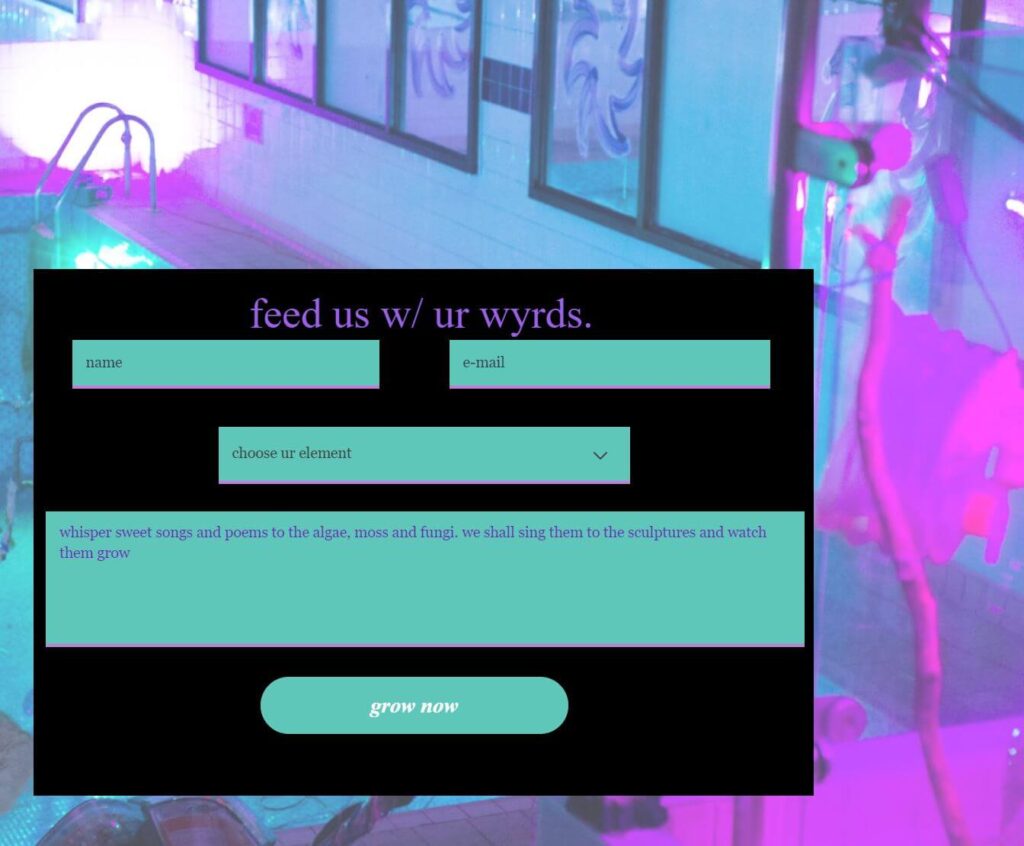
Through the long corridor patches of skin with markings obstructed your path. Flays of latex carrying the story of Pangu and debris from the destruction of the earth and the dystopian future paved the way to move forward.
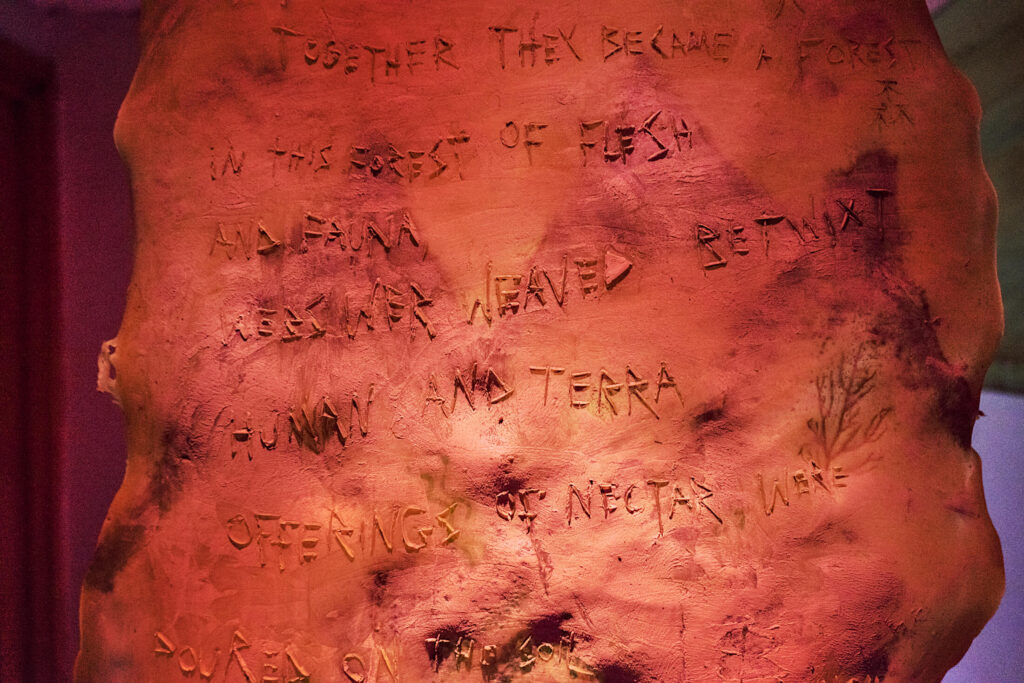
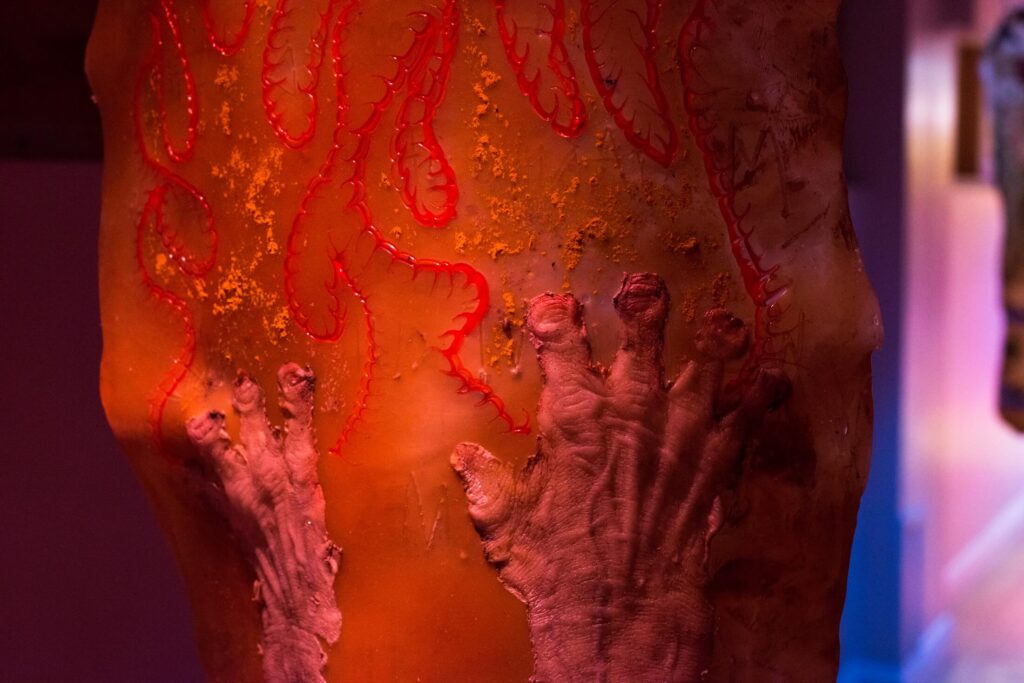


The title of the show is “Tectonic Incantations” – it’s an extension of my project “Parasites of Pangu”, so its full title is “Parasites of Pangu: Tectonic Incantations”. Parasites of Pangu is an opera that’s set very far in the future, in a climate where there are no humans left – basically, the earth has destroyed the humans but some of them– the “elite” humans, the 1% – were able to cast themselves off into space in cryogenic sleep, and wait for the earth to realign. The whole storyline has this thread of who deserved to survive, who can pay to survive, and what even is survival.
The name Pangu is the name of a deity or god from a Chinese creation myth called Pangu and the Cosmic Egg. Pangu was non-binary; before the world was created there was no gender, but in every Chinese writing or any historical text you’ll see they’ve used “he”. Pangu essentially held heaven and earth, or yin and yang, apart with their body, and it grew 10 feet every day as they held heaven and earth at bay & then one day it was too much for them and they dissolved. They collapsed, and their body became the earth, and their literal flesh became the soil, their bones became the rocks, their marrow became rare earth minerals, their voice became the thunder, their breath the wind, and the parasites that existed on Pangu’s body became the humans.
-Ayesha Tan Jones, December 2020.
Left and right you had vitrines with advertisements of the masks humanity needs to wear to survive, a work that Tan Jones began in 2018, way before everyone had to wear masks to survive.


At the end of the corridor, a strange persona wearing a mask appeared, a hologram like the ones that welcome you to an airport. The creation myth was ringing in your ears, smoke was blurring your vision, an enchanting and menacing music was taking over your mind.
Climbing the staircase, an announcement: END OF THE WORLD SALE.

Then you entered THAT space. A space you won’t forget. A space that was alive, in which you could hear water running and bubbles moving. You became aware of the blood and fluids that ran in your veins and travel around your body. You became aware of your body in this queer space, the bodies of others, of plants, moss, algae and other creatures that lived there. This was not an exhibition. It was a portal. And going through those previous spaces, following the path and the different stages, you ceremoniously, whether you liked it or not, found yourself in front of it.
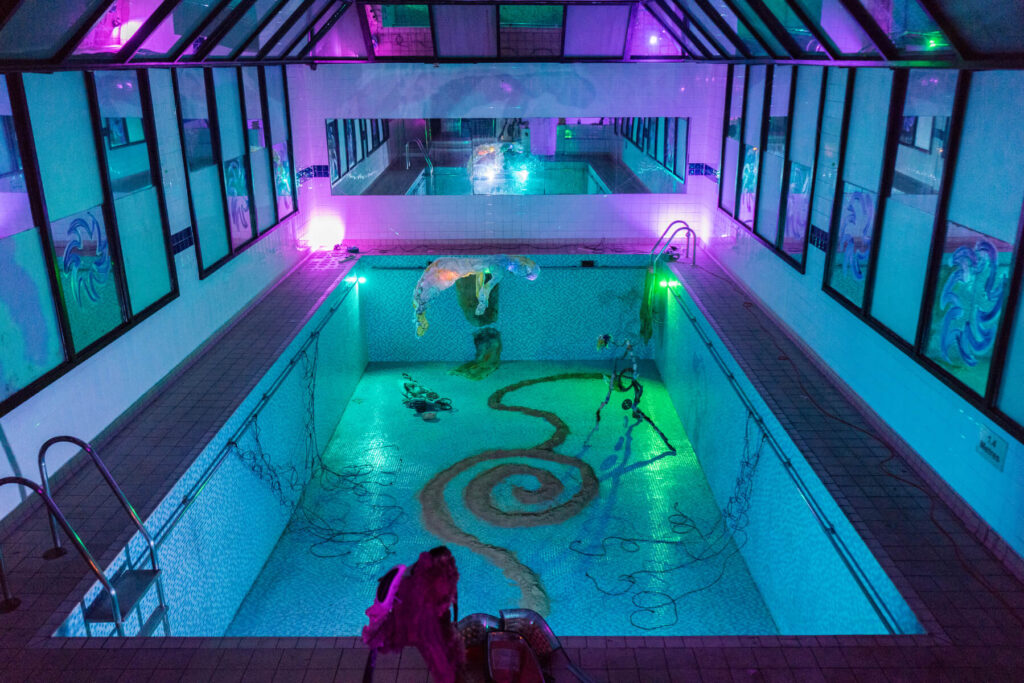

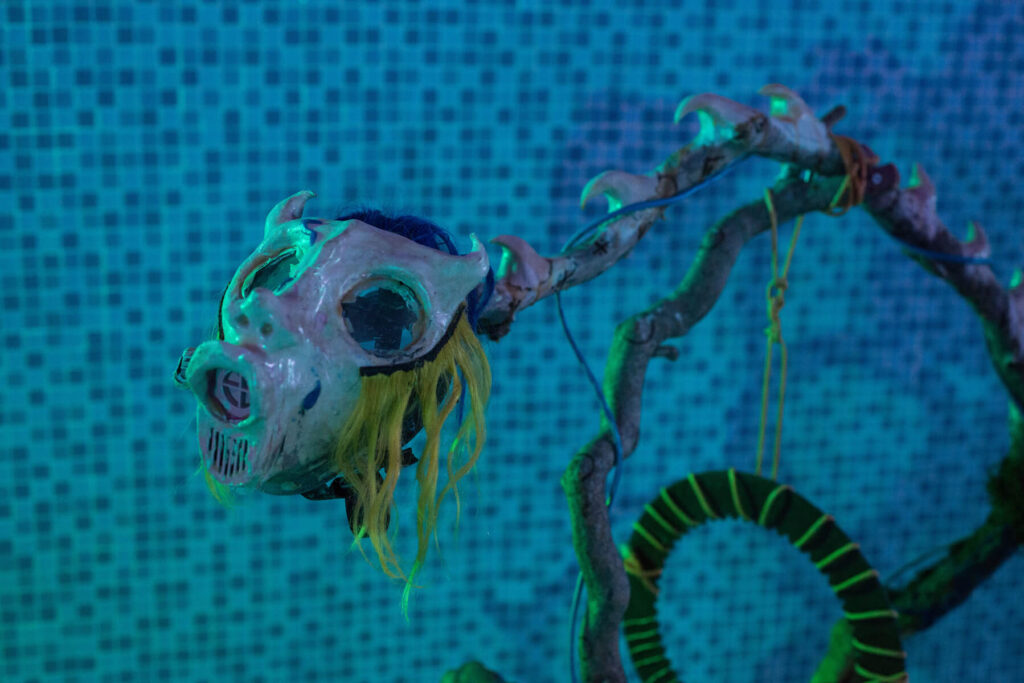
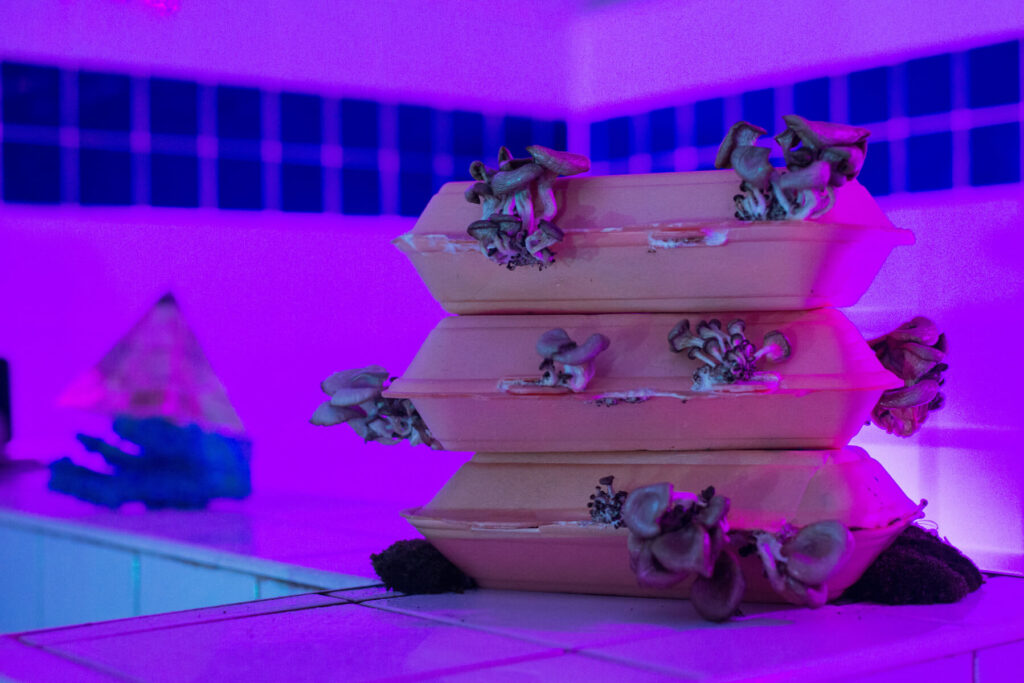
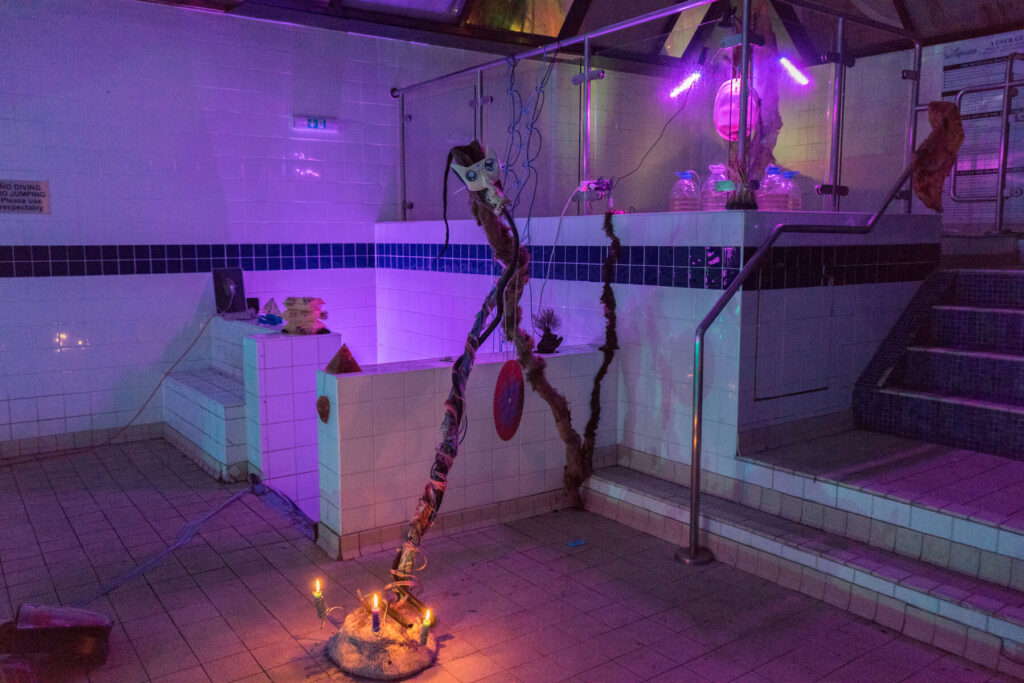
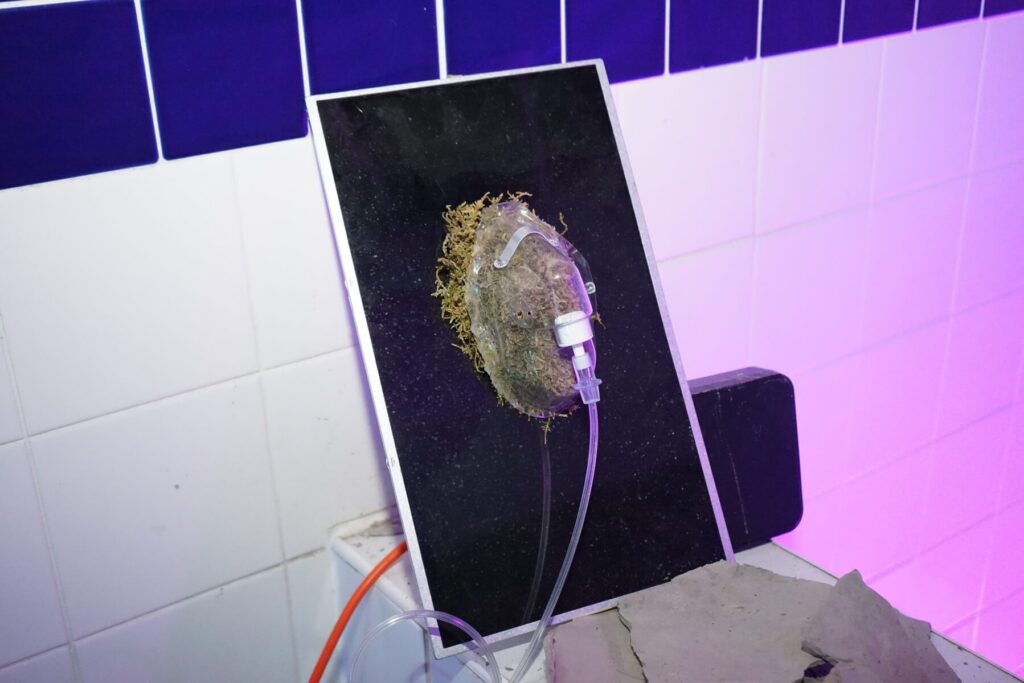
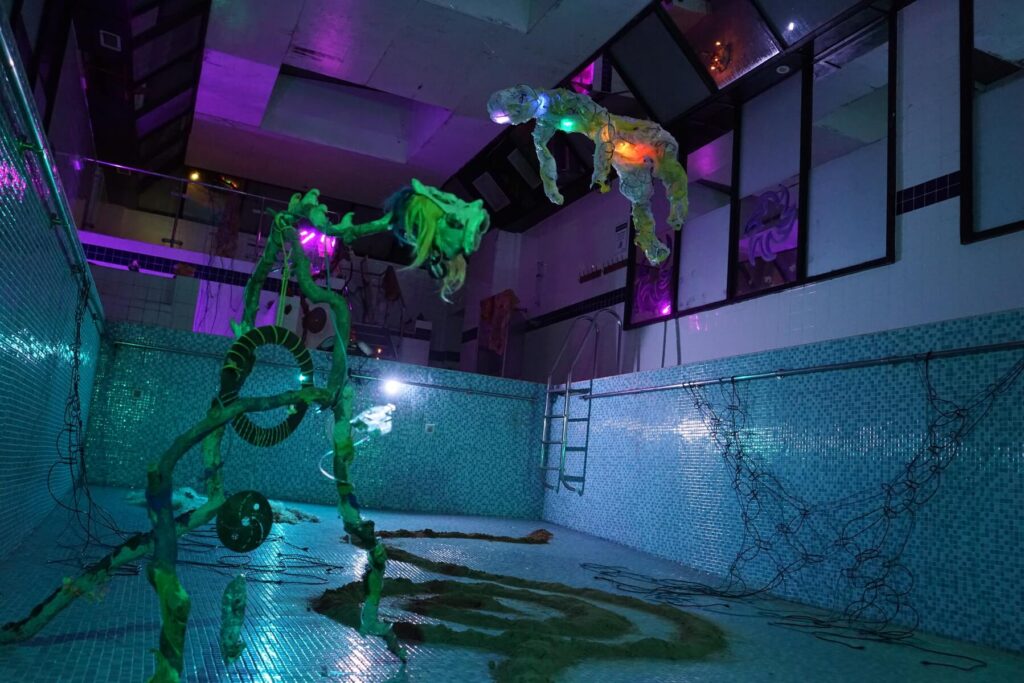
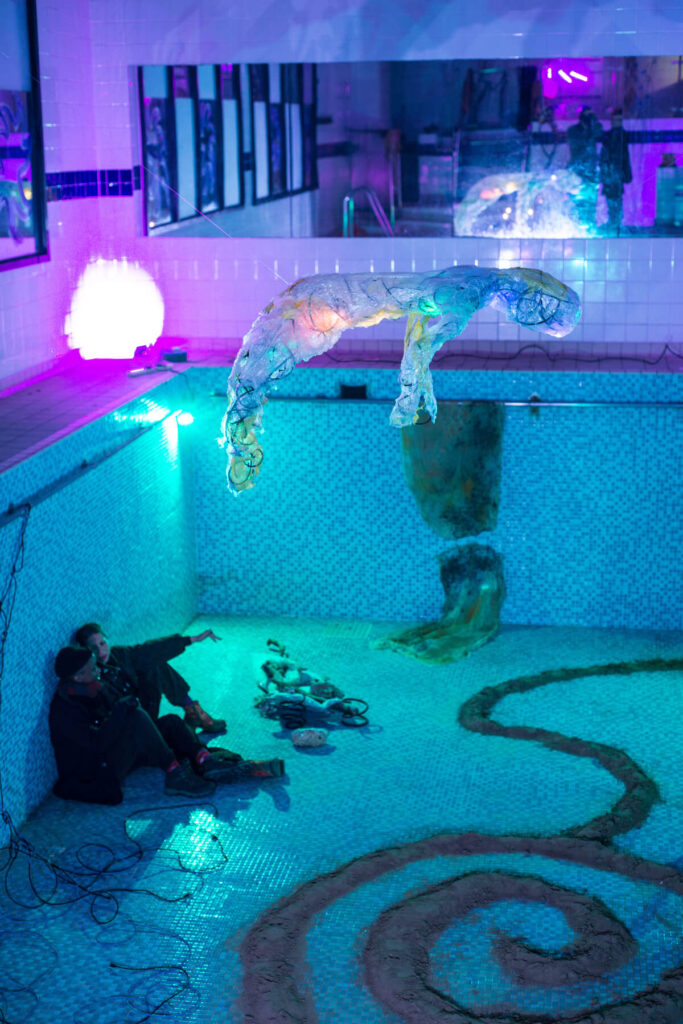
The experience of having been in that space is hard to put into words. But perhaps these will do.
List of works:
In the Leagues of a Thousand Shadows, The Swamp, Bio-diesel Farm, Future Skins, The Fire of Perpetual Darkness, Three Pleurotus ostreatus var. columbinus Quels, chilli sauce no mayo, Last Breath, Web of Word, Sand Spiral, Spirit, Prinx of the Underground.
List of materials:
Acrylic paint on canvas, tree branches, moss, plastic, internet cables, mushroom fountain, led lights, spiral wires, satellite dishes, algae, chlorella starter, water, nutrients, air, latex, yoghurt, wax, plastic, pva, ink, wires, cement, faux hair, band saw gong, tubing, electric fire fly controller, polystyrene takeaway containers, cardboard, mycelium, oyster mushrooms, plaster cast hands, copper sulphate, compost, clay from the forest, gas mask, oxygen mask, tubing, macramé, led lights, barley hay, bubble wrap, blonde wigs.
Once inside you became part of this ecology, this queer optimistic dystopia as Tan Jones describes it. Through the portal you saw a humanoid fluorescent body suspended in mid-air, above an empty pool that was now home to a soil spiral, strange creatures, hair and fungi, shredded latex skins, fishing nets made out of electrical cables. Elsewhere, moss was being given life via an oxygen mask, chlorella was bubbling and growing in water containers, more wires and skins hung over water and mushrooms grew out disposable takeaway food containers.
During lockdown, Tan Jones performed on certain nights livestreamed Tectonic Rituals, ceremonies of an apocalyptic, dystopian time, envisioning this speculative future, which for Tan Jones “is like having a fantasy world, and in that world I’m a sculptor and it feels almost like magic”.

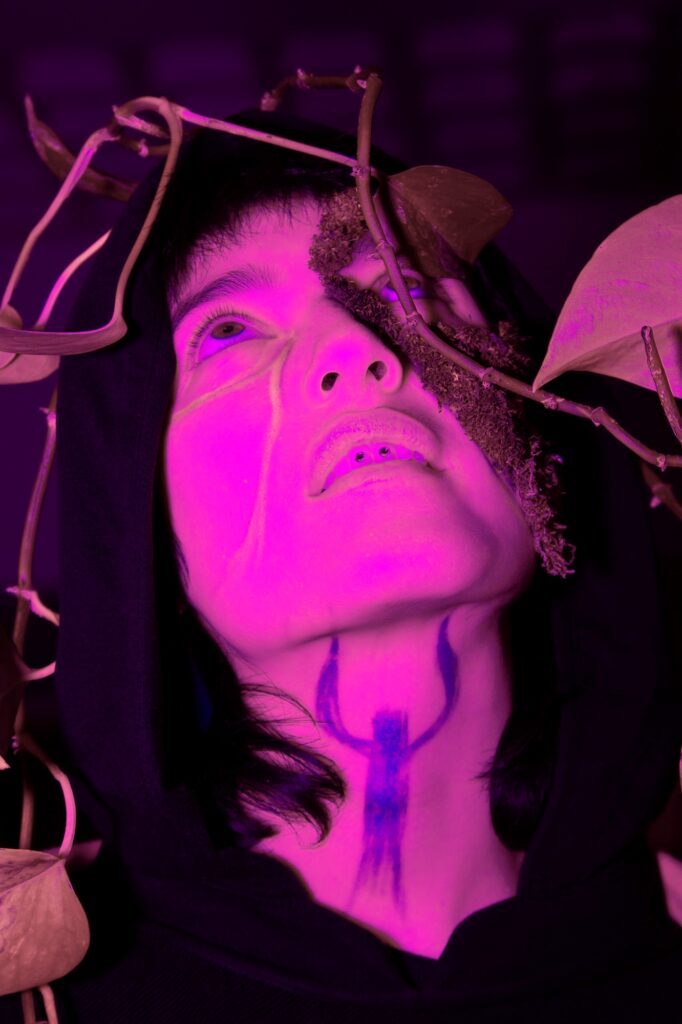
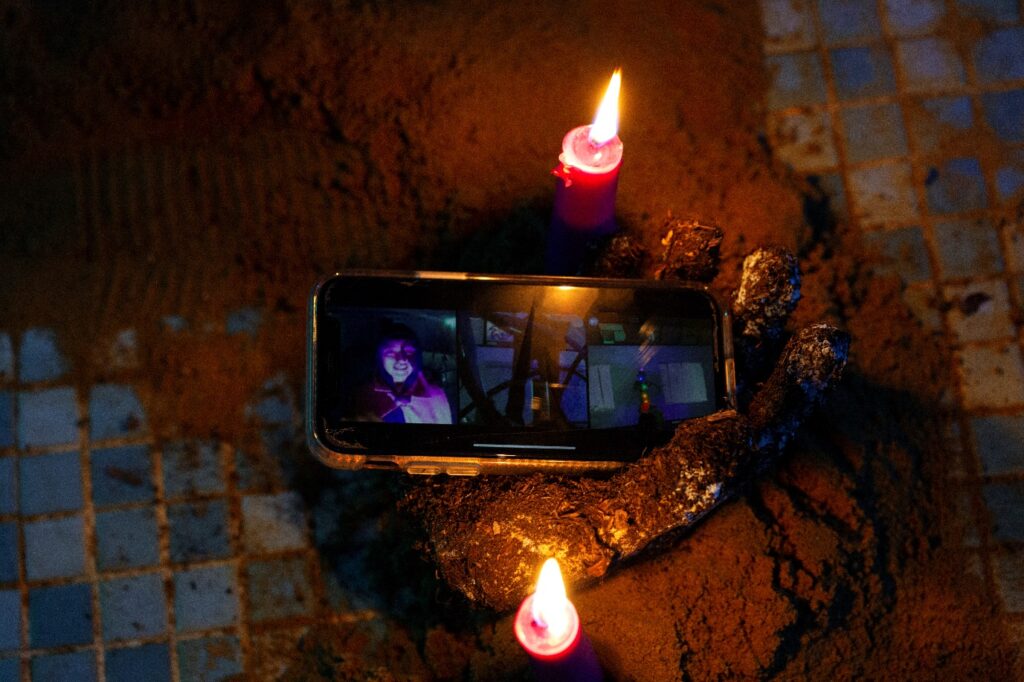
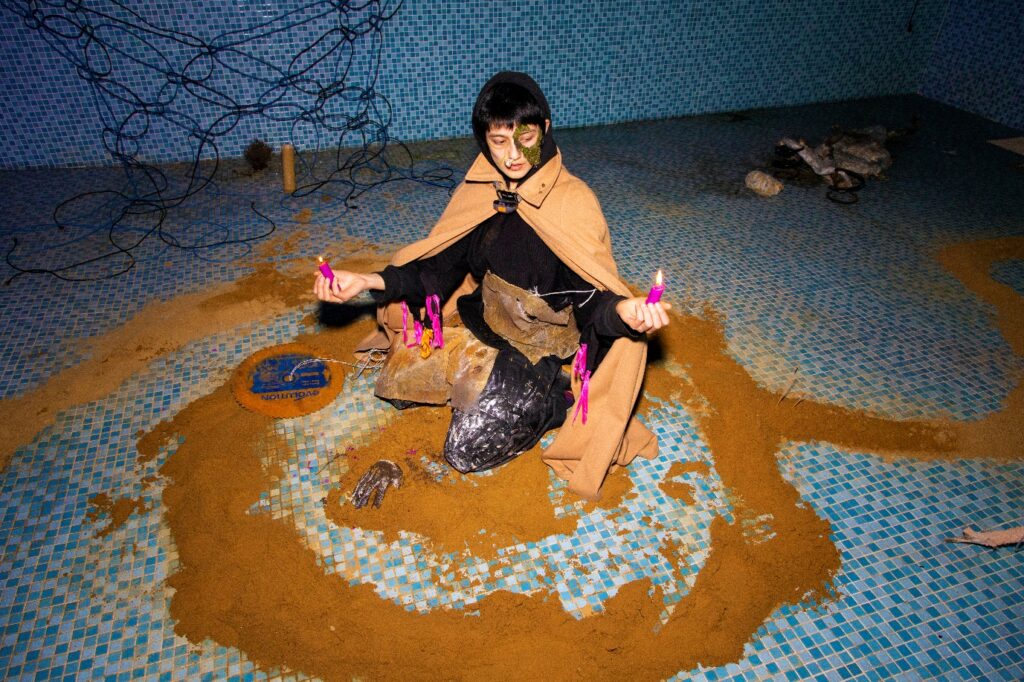
Composed of spells, words that helped the organisms thrive and grow, some magic and instructions to deal with what lives inside us, these were ceremonies unlike others. In their queer spatiotemporal dimensions, they showed us that a world where everything is connected already exists, and, that world, in all its future mycelium glory is upon us in excess mode. Through alchemy and practice, sci-fi and science, world making and destroying, Tan Jones performed ceremonies for a future in which they most likely become extinct. This is the essence of the queer optimistic dystopia they are anticipating:
With my work I intend to instil a glimmer of optimism. That’s why I used the term “optimistic dystopia” to describe my art. It’s accepting and acknowledging and surrendering to the dystopia; it’s perpetual, and it’s everywhere, and we’re in it, but how do we take the skills that we know and survive it – and thrive, actually – not just survive it but thrive through it.
Ayesha Tan Jones, December 2020.
These ceremonies are the tools for navigating that future. The bare bones of future bodies, future selves and ways of existing. Beings that will be free to thrive in the future even if its image is dystopic. Because they participated in the ceremonies of today.
INHALE ______ EXHALE
A few months later, another artist took residence in the space. I use the words “took up residence” here not to point to your typical artist residency, this was not the case. Agnes? entered the space and made it literally her home. A home that feels like a womb, like an octopus, like the bottom of the sea, like outer space, like a place where anything goes, any being and state of being is possible.
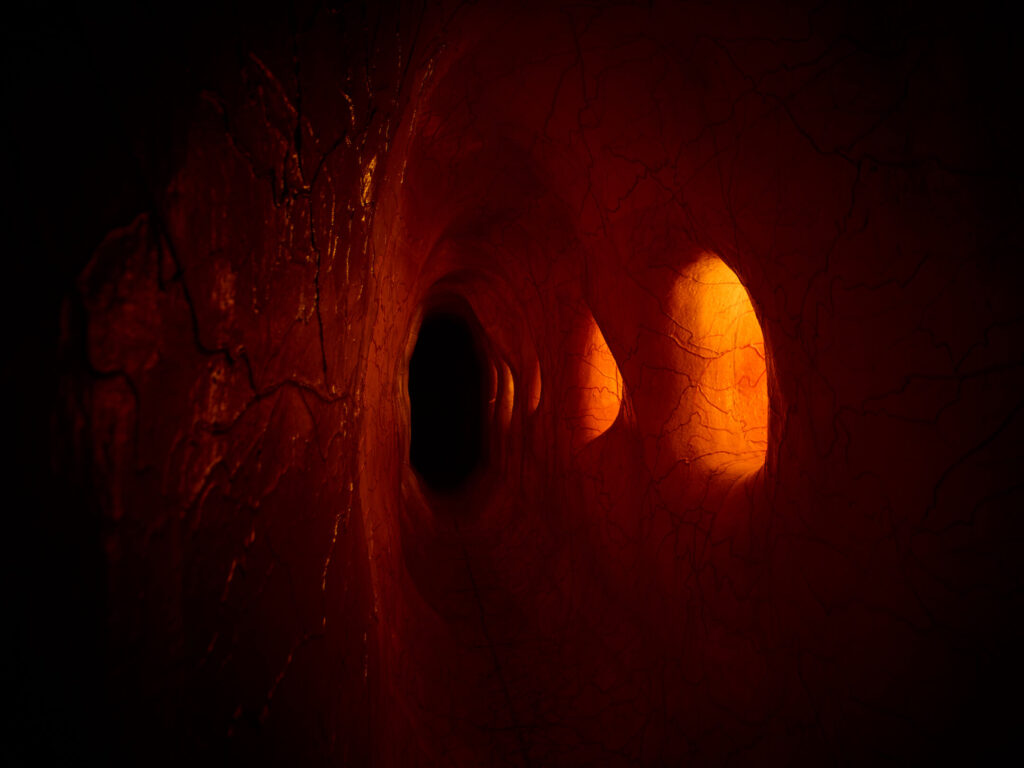

The corridor, the first space you must go through to reach the rest of the derelict spa areas, was transformed into a strange, bodily, veiny, skin-like pathway. As soon as you entered, it was as if a huge beast had swollen you whole. Your whole body and footsteps were pressing against what looked and felt like intestines, massive internal organs covered with red veins that could be carriers of blood and information. With every step you wondered if the veins had let the creature know that you had entered its belly. If it could feel you moving inside it. The sound of a heartbeat was surrounding you. Walking in you realised you were not alone. Embryos, human and cephalopod-like were inside holes that were connected to this bio superstructure. They were gestating, growing, developing.
The feeling after leaving this corridor, was like a body has ejected you. A birth had already happened. Exiting the womb, you found yourself into a room that felt like an underwater environment, swimming in a submerged world of colourful creatures.
Walking on a bed of salt, you moved around beautiful cephalopods, while at the end an extraordinarily big anemone was casting its tentacles to the ceiling. Everything here was tentacular. Everything reached upwards, outwards, beyond the confines of a being’s immediate physical space.
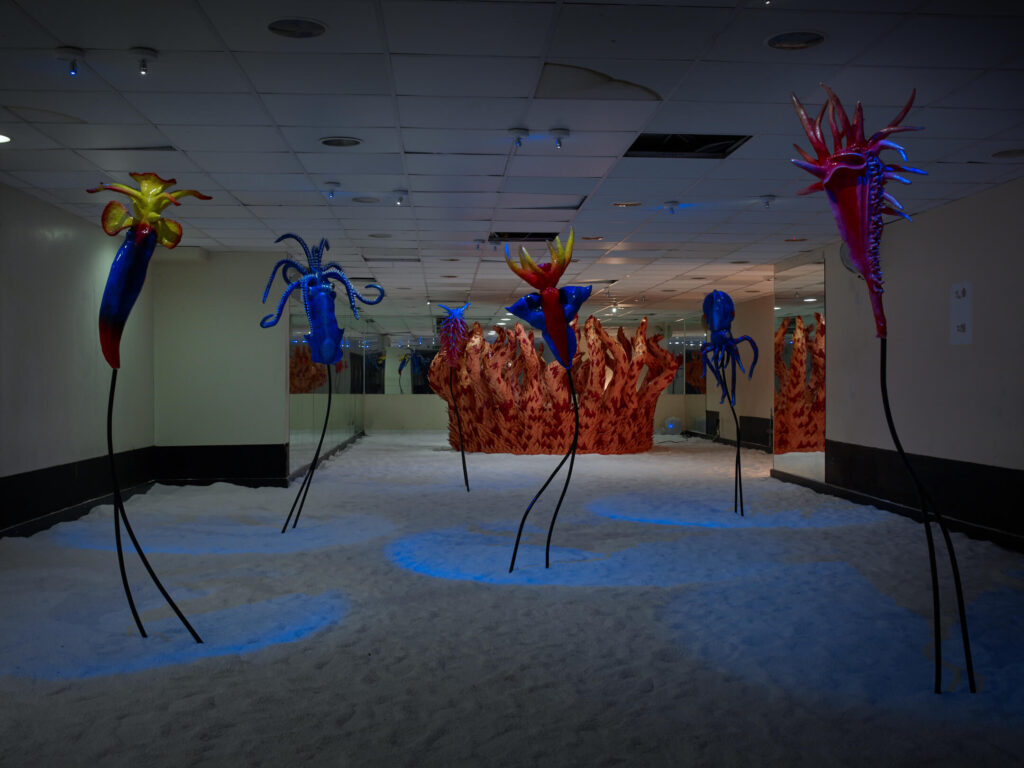
Strange but familiar sounds, like the underwater call of a whale, the exhale or the muffled scream of an animal, of things moving and cracking, were around you. On certain times, this seabed was also home to performance. Agnes? in collaboration with Magnus Westwell, released six dancers in this curious sea to move together with its underwater creatures. An uncanny sense of moving and reaching, touching and exploring, filled the room with every tentacle motion the performers extended. Dressed in almost translucent fabric, like a frail second skin, these bodies looked and felt like new-borns as well. Free and capable to explore and connect with each other and with this strange world as they wished.

Out of the sea and up the stairs, I knew to expect the swimming pool again. But what was in there this time was different. I had arrived at the source, to the creator of this interspecies ecology, to an enormous part-human, part-octopus, submerged into the pool and standing tall in front of everyone to see. I had arrived to meet Agnes?

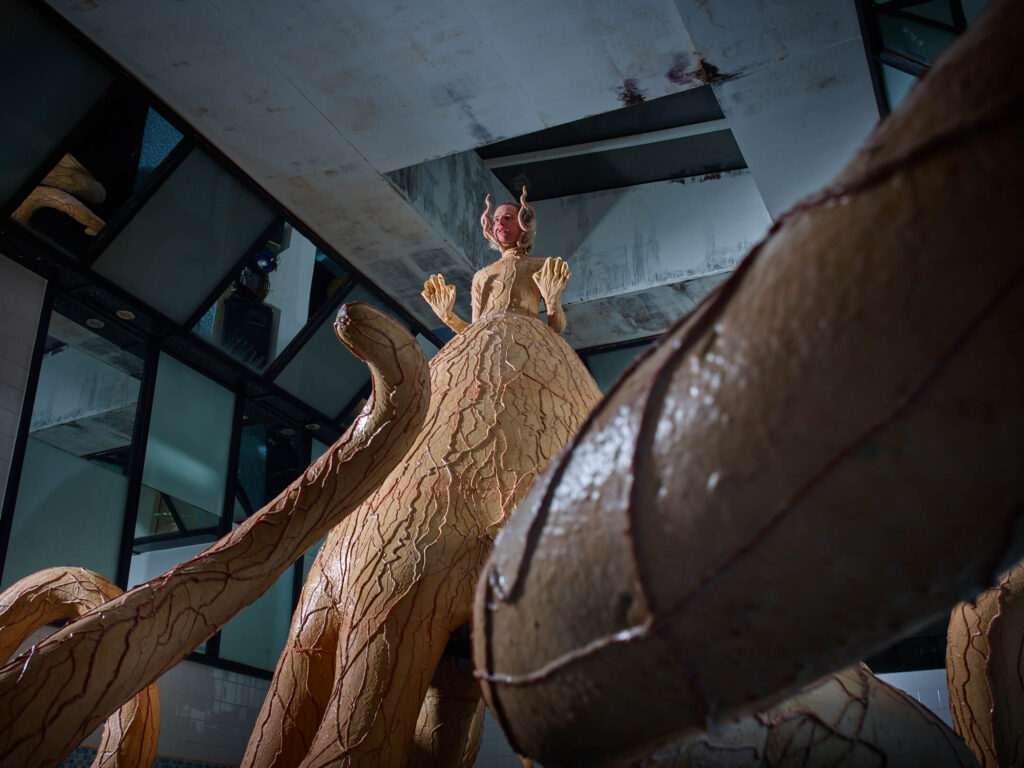
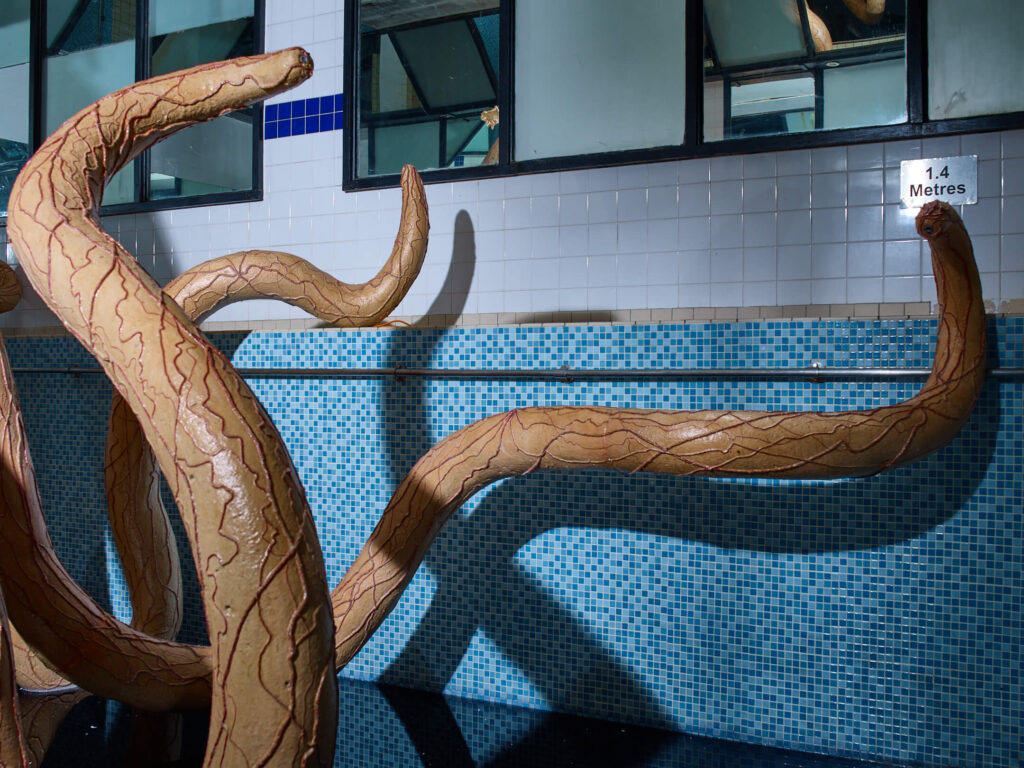

The room was dark, all lights were on this creature. The soundscape was at once captivating, frightening and alluring, while Agnes?’ elaborate breathing filled the abandoned swimming pool, as she reached and stretched her arms outwards, as if they were producing oxygen themselves, as if this creature was providing something that is of vital essence to those who were around it.
This creature was alive 8 hours a day, every day, for the 23 days that was the run of the exhibition, a total of 184 hours of performance. When I visited the show and spent some time with Agnes? she informed me that this was a transition process. The artist had started her transition journey as she began to work on installing the show in the space.
“It was important to me to play with the space, to consider the actual space as a body in itself. I was creating a new body, but at the same time, I was presenting the space as a body. I like to consider the whole space as an extension of my body. As if the octopus is giving birth — is giving life — to everything else.”
“I’m giving birth to something new, but I’m also destroying something from my past. Transitioning itself, it’s a destruction. The hormones destroy part of you — you need to destroy part of your body to lead to new creations. The octopus does the same — it’s a creature that represents the great mother, the dedicated mother who, at the end of her life, dies for her offspring, letting her body be consumed.”
“I’m transitioning, the work is a transition, the people who enter the space need to transition. It’s an invitation to open your mind.”
Agnes?, May 2020.
Layering this environment with the register of personal experience, with the medical and scientific journey on bodies that ask for it rather than those that it’s enforced upon, in their quest for a state of being that is more-than-human, transformed this experience into a ceremony. But not one that celebrates the result, not one that you need to go through in order to reach an end goal. Through Agnes?’ exhaustive sharing and reaching this became a ceremony of transitivity itself. The makings of a ceremony that is usually clinically performed on bodies, were overturned, they became the very thing that was under examination, they became the exoskeleton from which the bodies of the future will break away and emerge.
And these bodies, this future, are tentacular. They are all interconnected, across flesh and time, they move together, perform together, gestate together, die and rise together.
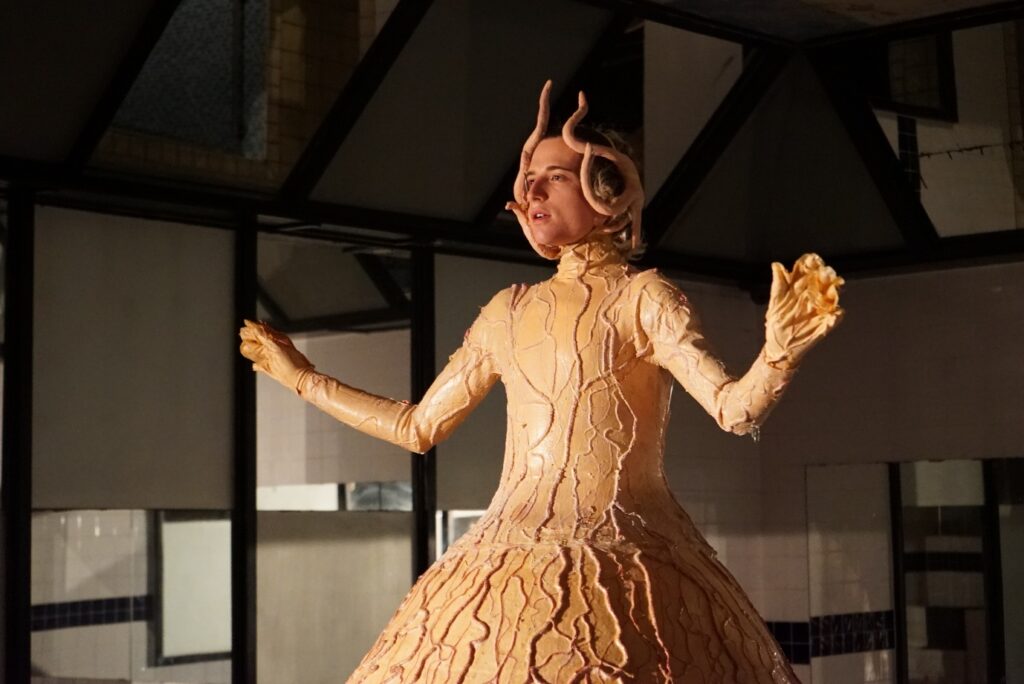
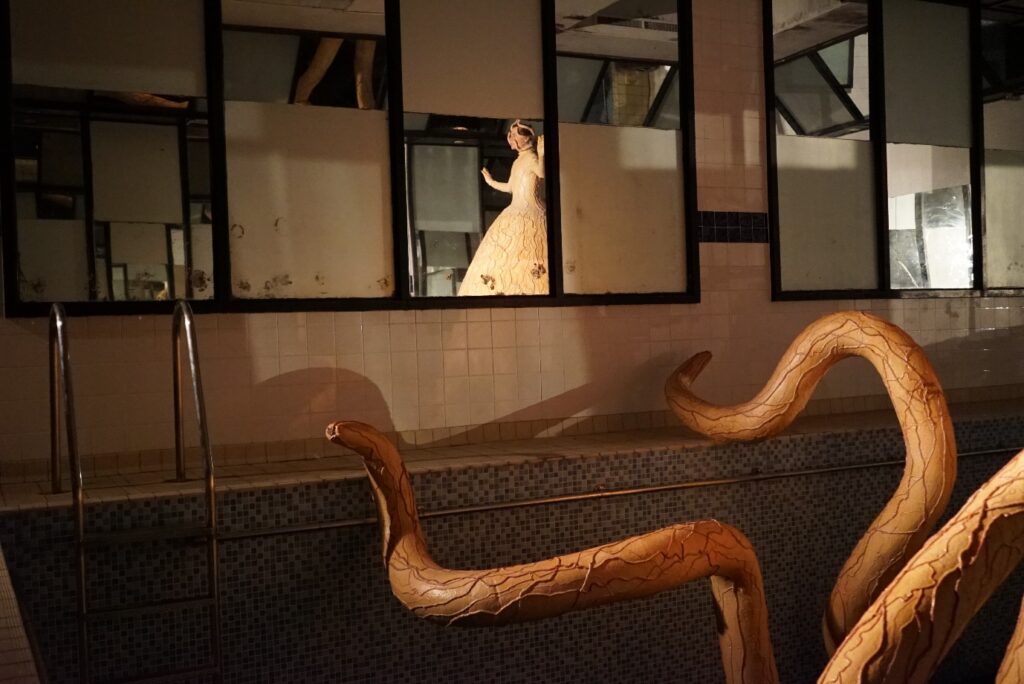
I didn’t want to leave. I wanted to spend time with this creature. I fluctuated from observation to contemplation, to meditation, to the desire to mimic its movements, feeling its gasp for air, its tentacles approaching, its thirst to give birth to children, siblings, clones, whatever these beings may end up being, to witness the birthing ceremony of an alternate present and what felt like a very real future.
INHALE ______ EXHALE
Tectonic Incantations and Transgenesis offered entry points and portals to emancipatory, apocalyptic and radical care ceremonies, but their most important offering was anti-ceremonious; they articulated tectonic and tentacular politics of being. These types of ceremonies reach out like tentacles and shake the earth like tectonic plates. They grip us and shake us so hard that any kind of beginning, middle and end collapses. There is no linear ceremony to follow, everything is linked. So that the landscape that emerges is one in which we are more connected to each other, to other beings, to soil, to sea, to stars, and that our existence, our true, free, queer and polymorphous self is not a vision of a self that is only possible in a galaxy far away. This, is here, and it is here now. It has ceremoniously finally arrived, if you must.
Thank you to Ayesha Tan Jones and Agnes? for sharing their work with me, our ongoing dialogue and their friendship. Thank you to the teams of people who worked to make these projects come alive and for inviting me to be part of them. Thank you Nadja for inviting me and creating this space full of potentiality.
Credits:
Ayesha Tan Jones, Tectonic Incantations, December 2020 – February 2021. Produced by Harlesden High Street with support from Mimosa House. Curated by Daria Khan.
Agnes?, Transgenesis, May 2021. Curated by Arturo Passacantando, Tommaso de Benedictis and Charlie Mills and in partnership with Harlesden High Street.
)
)